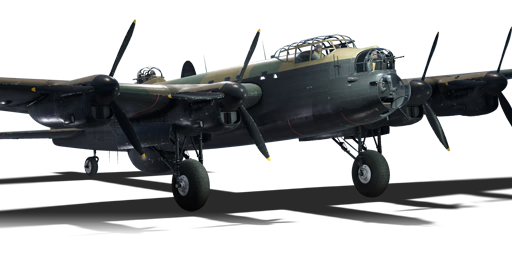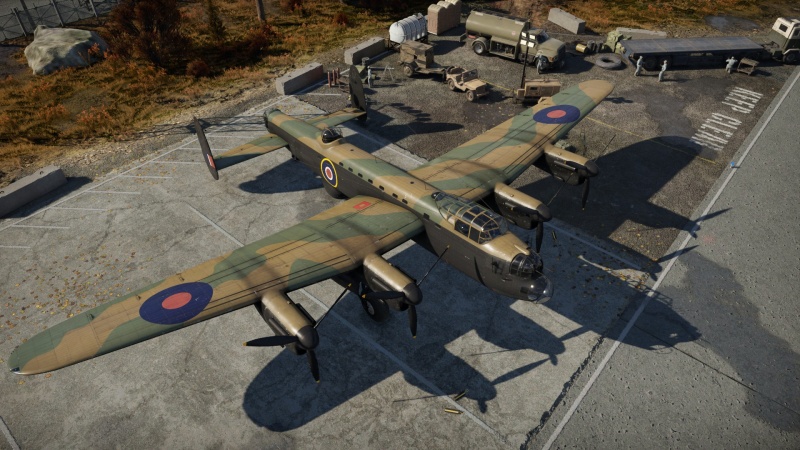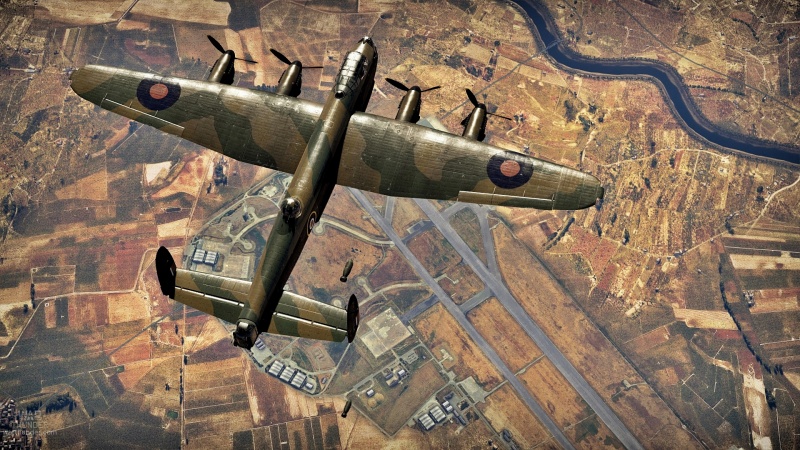Lancaster B Mk I
| This page is about the British bomber Lancaster B Mk I. For other versions, see Lancaster (Family). |
Contents
Description
The Lancaster B Mk I is a rank IV British bomber with a battle rating of 5.0 (AB), 5.3 (RB), and 5.7 (SB). It was introduced in Update 1.43.
Developed from the troublesome Avro Manchester, the Avro Lancaster is a long-range heavy bomber optimised for delivering huge payload over long distances. Compared to its contemporaries like the American B-17 or the German Fw 200, the Lancaster carries twice the payload while being generally easier to handle. Because of this, the "Lanc" is an ideal bomber for destroying bases and airfields with bombs from high altitude.
Because of the optimization for large payload and good manoeuvrability, the early Lancaster have a very poor set of defensive armaments consists of a small .30 cal machine guns. This will not help to ward off any pursuing enemy fighters and thus leaves the plane vulnerable to any other planes save for another heavy bomber. On the other hand, the Lancaster's ease of control and overall good flight performance allows the plane to reach the destination relatively quickly and get the job done.
General info
Flight performance
Unlike other heavy bombers, the Lancaster is surprisingly responsive and easy to handle. While it is not going to win any dogfights, the plane can steer and bank around well enough to adjust the bomb sight for accurate drop. The plane can also maintain its admittedly slow speed quite well, owning to four powerful Merlin engines. This allows the Lancaster to do a shallow descent and reach the base just in time before enemy fighter arrives.
One peculiar characteristic of the Lancaster is its unusually high wing structural limit speed for a heavy bomber, at 600 km/h IAS. This unusual trait allows the Lanc to "dive" towards enemy bases at speed, thus allowing it to be played in high risk, high reward "fast bomber" roles.
| Characteristics | Max Speed (km/h at 3,048 m) |
Max altitude (metres) |
Turn time (seconds) |
Rate of climb (metres/second) |
Take-off run (metres) | |||
|---|---|---|---|---|---|---|---|---|
| AB | RB | AB | RB | AB | RB | |||
| Stock | 437 | 423 | 7800 | 43.2 | 44.4 | 7.0 | 6.8 | 750 |
| Upgraded | 465 | 451 | 40.9 | 42.0 | 10.4 | 8.6 | ||
Details
| Features | ||||
|---|---|---|---|---|
| Combat flaps | Take-off flaps | Landing flaps | Air brakes | Arrestor gear |
| ✓ | ✓ | ✓ | X | X |
| Limits | ||||||
|---|---|---|---|---|---|---|
| Wings (km/h) | Gear (km/h) | Flaps (km/h) | Max Static G | |||
| Combat | Take-off | Landing | + | - | ||
| 608 | 338 | 415 | 381 | 282 | ~4 | ~3 |
| Optimal velocities (km/h) | |||
|---|---|---|---|
| Ailerons | Rudder | Elevators | Radiator |
| < 400 | < 350 | < 350 | > 350 |
Survivability and armour
- 8 mm Steel plate on each pilot's headrest.
- 6.35 mm Steel plate behind each engine.
Modifications and economy
Armaments
Suspended armament
The Lancaster B Mk I can be outfitted with the following ordnance:
- 14 x 250 lb M.C. Mk.I bombs (3,500 lb total)
- 14 x 500 lb M.C. Mk.I bombs (7,000 lb total)
- 6 x 500 lb M.C. Mk.I bombs + 8 x 250 lb M.C. Mk.I bombs (5,000 lb total)
- 14 x 1,000 lb M.C. Mk.I bombs (14,000 lb total)
- 1 x 1,000 lb M.C. Mk.I bomb + 6 x 500 lb M.C. Mk.I bombs + 2 x 250 lb M.C. Mk.I bombs (4,500 lb total)
- 6 x 1,000 lb M.C. Mk.I bombs + 3 x 250 lb M.C. Mk.I bombs (6,750 lb total)
- 1 x 4,000 lb H.C. Mk.II bomb (4,000 lb total)
- 1 x 4,000 lb H.C. Mk.II bomb + 6 x 1,000 lb M.C. Mk.I bombs + 2 x 250 lb G.P. Mk.IV bombs (10,500 lb total)
- 1 x 8,000 lb H.C. Mk.II bomb (8,000 lb total)
- 1 x 8,000 lb H.C. Mk.II bomb + 6 x 500 lb G.P. Mk.IV bombs (11,000 lb total)
- 1 x 12,000 lb H.C Mk.I bomb (12,000 lb total)
Perhaps the most famous quality of the Lancaster is its huge payload. Though the stock payload of 14 x 500 lb bombs are quite mediocre, the Lanc only requires the "AUBC No.1 Mark II" modification to unlock its most efficient payload; 14 x M.C. 1,000 lb bombs with roughly 6,600 kg of total payload. This massive payload can easily take out two bases even in uptiers and is effective against columns of vehicle and stationary targets.
In addition, the Lancaster also has access to the massive "Blockbuster" bombs with devastating explosive power. The 12,000 lb version in particular dethrones the infamous FAB-5000 bomb as the most powerful bomb in the game. With 6,300 kg of TNT equivalent, the bomb can easily destroy a group of vehicles in ground battles or sink a battleship in a single hit in naval battles.
Defensive armament
The Lancaster B Mk I is defended by:
- 2 x 7.7 mm Browning machine guns, nose turret (1,000 rpg = 2,000 total)
- 2 x 7.7 mm Browning machine guns, dorsal turret (1,000 rpg = 2,000 total)
- 4 x 7.7 mm Browning machine guns, tail turret (2,500 rpg = 10,000 total)
Despite its size and payload, the Lancaster has a disproportionally small defensive armaments consists of eight .30 Browing machine guns distributed in one quadruple turret at the tail and two double turrets at the dorsal and nose position. These armaments has very poor damage output against any targets and is practically useless beyond 800 metres range.
However, against some enemies (such as radial engine fighters), these small machine guns can be surprisingly deadly against those who underestimate it, as the guns has good accuracy at close range and relatively good rate of fire, along with the fact that six out of eight guns can be aimed towards the chasing enemy at the rear. With careful aiming at their engine, the guns were capable of knocking it out or setting them on fire providing that enough shots were hit, potentially netting some kill.
On the other hand, the Lanc's limited defensive armaments and coverage can be easily bypassed by simply attacking from anywhere but the tail, leaving the plane with little to no way to fight back. In addition, the gunners and ammo feeding mechanisms of the Lancaster is practically exposed to enemy fire, meaning that it has significant chance of getting knocked out.
Usage in battles
The Lancaster carries the heaviest bomb load of any bomber before the American Boeing B-29 Superfortress, at a fantastic 14,000 lb (6,363 kg), and the heaviest of any British bomber in the game. It can quickly end games if left to go about its business. The Lancaster also has relatively good performance and agility for a four-engined heavy bomber, significantly better than both the American B-17 and B-24 bombers.
Unfortunately, the Lancaster is extremely vulnerable if intercepted by enemy fighters. Its defensive armament consists only of .303 in Browning machine guns; while they have a high rate of fire, they are not very lethal to enemy fighters outside of a lucky fire set by the incendiary bullets. In addition, the Lancaster has no ventral turret covering attacks from below due to H2S radar unit (a useless feature in the game). The aircraft itself is not very durable as well and is extremely vulnerable to cannons of 20 mm calibre and larger.
The safest way to use this bomber is to attack bases from around the map. Do a big circle-around, go to the corner, and aim the nose to the remaining enemy bases. Side climbing is not recommended because of the Lancaster's terrible climb rate; not to mention the ease that enemy fighters like German and American ones can easily reach the bomber even at 7,000 m altitude. Instead stay between 2,500 and 4,000 m and build up speed. Use the Lancaster's amazing payload and drop three of the 1,000 lb bombs onto each base. In the airfield bombing scenario, get altitude not less than 3,000 m and drop all the bombs onto the main runway for better accuracy. Try to stay near friendly fighters for air cover.
On the other hand, the Lancaster can be played as an ad-hoc fast bomber by exploiting its relatively high wing rip speed to quickly dive into the enemy base. As the Lanc has high altitude spawn, one can use this to dive towards the enemy bases and destroy them before the enemy arrives. Though this will also leave you vulnerable to any attackers and interceptors should they spot you earlier, this high risk, high reward tactic will almost guarantee at least one base and potentially two if the enemy does not arrive in time. While in a dive, be sure to watch your IAS to not exceed the wing rip speed of 600 km/h, and throttle down your engine and pull your nose up while near the base to adjust the bomb aim.
Manual Engine Control
| MEC elements | ||||||
|---|---|---|---|---|---|---|
| Mixer | Pitch | Radiator | Supercharger | Turbocharger | ||
| Oil | Water | Type | ||||
| Not controllable | Controllable Not auto controlled |
Controllable Auto control available |
Controllable Auto control available |
Separate | Controllable 2 gears |
Not controllable |
Pros and cons
Pros:
- Massive bombload of up to 6 tons, including the Blockbuster bomb
- Powerful Merlin engines providing good performance
- Excellent handling and manoeuvrability
- 6 x 7.7 mm MG facing upper rear area which can be lethal to some targets with careful aiming
- 4 engines means that it can maintain flying ability despite damage to some engines
- H-tail means that if one rudder is shot off, the other one still works
- Relatively high wing rip speed allows the plane to be played as an improvised fast bomber
Cons:
- Very low durability
- Is a big and slow target
- No armour plates protecting gunners and ammo feeding mechanisms
- Pathetic defensive armament due to their small calibre and bad damage. Cannot effectively hurt heavily armoured interceptors such as Me 410.
- No turret coverage for the belly
- Easily damaged elevators and tail controls
History
The Avro Lancaster is a long-range heavy bomber built and designed by A.V. Roe and Company (or Avro). It was developed as an "upgrade" from the Avro Manchester which was disliked by crews for its difficulty to fly and underpowered engines.
The Lancaster was designed by Roy Chadwick and first flew on 9th January 1941; entering service in 1942. It was produced by Avro, Armstrong Whitworth, Austin Motors, Metropolitan-Vickers, Vickers Armstrong and Victory Aircraft (for the RCAF)
The Lancaster's long, unobstructed bomb bay enabled it to carry the largest bombs the RAF used (including 4,000, 8,000, 12,000 and - when modified - 22,000 lb bombs). Because of this, it soon became the most widely used British bomber of World War II.
No. 617 squadron famously used modified Lancasters during Operation Chastise in dam raids in the Ruhr Valley, using Barnes Wallace's Upkeep Mine (or "Bouncing Bomb" as it became known as). This gave 617 squadron the nickname "The Dambusters", sparking the creation of a film by the same name.
| Archive of the in-game description | |
|---|---|
|
With RAF Bomber Command's focus being centred on the strategic bombing campaign against German industry, the RAF desperately required a force of heavy bombers to increase the capability provided by their medium bomber fleet. A twin engine Avro Manchester bomber was converted to be powered by four engines and first flown in January 1941. This and subsequent prototypes were deemed to be so successful that the first production variant of the new bomber, now named the Lancaster, was flown in October 1941. Powered by four Rolls Royce Merlin XX engines rated at 1280 hp, (later upgraded to Merlin 22 or 24s) the Lancaster B.I was capable of reaching speeds of up to 275 mph. With a standard fuel load it could carry 10,000 lbs of bombs over 1,000 miles. The maximum ordnance capacity of the Lancaster was one of the highest of any heavy bomber in World War II: 14,000 lb (6,356 kg). Besides standard bombs, the aircraft could carry an 8,000 lb (3,632 kg) "blockbuster" or two 4,000 lb (1,816 kg) high-explosive "cookie" bombs. Special modifications of the bomber could carry even larger bombs, such as the 22,000 lb 'Grand Slam' bomb. For defence, the Lancaster had eight 0.303 inch Colt-Browning Mk.II machine guns located in three turrets: two guns were located in the nose, two in the dorsal turret, and four in the tail turret. This defensive armament was considerably lighter than that of the Lancaster's US counterparts; it relied on darkness for protection rather than firepower. However, even though on paper the Lancaster was an impressive strategic asset, it still had its weaknesses: whereas the Halifax and Stirling could both claim a crew survival rate of 25% in the event of destruction, the Lancaster could only claim a survival rate of 15% for its crews. 58% of all RAF Lancasters were destroyed in combat; a higher loss percentage than any other British aircraft during the entire war. The Lancaster was first used operationally in March 1942 by No. 44 Squadron. It soon became the backbone of RAF Bomber Command's offensive against the heart of Germany, but was also used against targets all across occupied Europe. The majority of Lancaster operations took place at night due to RAF Bomber Command's policy of night bombing whilst the bombers of the United States Army Air Force tackled targets by day. The Lancaster became legendary on the night of May 17th 1943 when bombers of No 617 Squadron breached the Mohne and Eder dams in Germany with Barnes Wallis' genius 'bouncing bomb'. Lancasters of Nos 9 and 617 Squadrons also sank the German battleship 'Tirpitz' with 12,000 lb 'Tallboy' bombs, also designed by Wallis. Over 3,400 Lancaster B.Is were manufactured between November 1941 and March 1946, making it the most numerous of the Avro Lancaster variants. In addition to RAF operations, the Lancaster was also used by the RAAF and RCAF. | |
Media
- Skins
See also
Links to the articles on the War Thunder Wiki that you think will be useful for the reader, for example:
- reference to the series of the aircraft;
- links to approximate analogues of other nations and research trees.
External links
- Video on "Grand Slam" bomb (History section) https://www.youtube.com/watch?v=R-Mm-zFW_nA&feature=relmfu
- Lancaster "Data Card" (History section) click here
- Heavy Bombs (History Section) https://www.iwm.org.uk/collections/item/object/205210816
- General Information (History Section) https://books.google.co.uk/books?id=0SkDAAAAMBAJ&pg=PA48-IA3&redir_esc=y#v=onepage&q&f=false
| Avro Aircraft | |
|---|---|
| Bombers | Lancaster B Mk I · Lancaster B Mk III · Lincoln B Mk II · Shackleton MR.Mk.2 |
| Export/Licensed | Lancaster MR.7 |
| Britain bombers | |
|---|---|
| Torpedo | Swordfish Mk I · Swordfish Mk II · ▄Avenger Mk II |
| Dive | V-156-B1 |
| Hydroplanes | ▄Catalina Mk IIIa · Sunderland Mk IIIa · Sunderland Mk V |
| Light | Blenheim Mk IV · Beaufort Mk VIII · ▄Hudson Mk V · Brigand B 1 |
| Based on A20 | ▄Havoc Mk I · ▄Boston Mk I · ▄DB-7 |
| Hampden | Hampden Mk I · Hampden TB Mk I |
| Wellington | Wellington Mk Ic · Wellington Mk Ic/L · Wellington Mk III · Wellington Mk X |
| Halifax | Halifax B Mk IIIa |
| Stirling | Stirling B Mk I · Stirling B Mk III |
| Lancaster | Lancaster B Mk I · Lancaster B Mk III |
| Lincoln | Lincoln B Mk II |
| Shackleton | Shackleton MR.Mk.2 |






